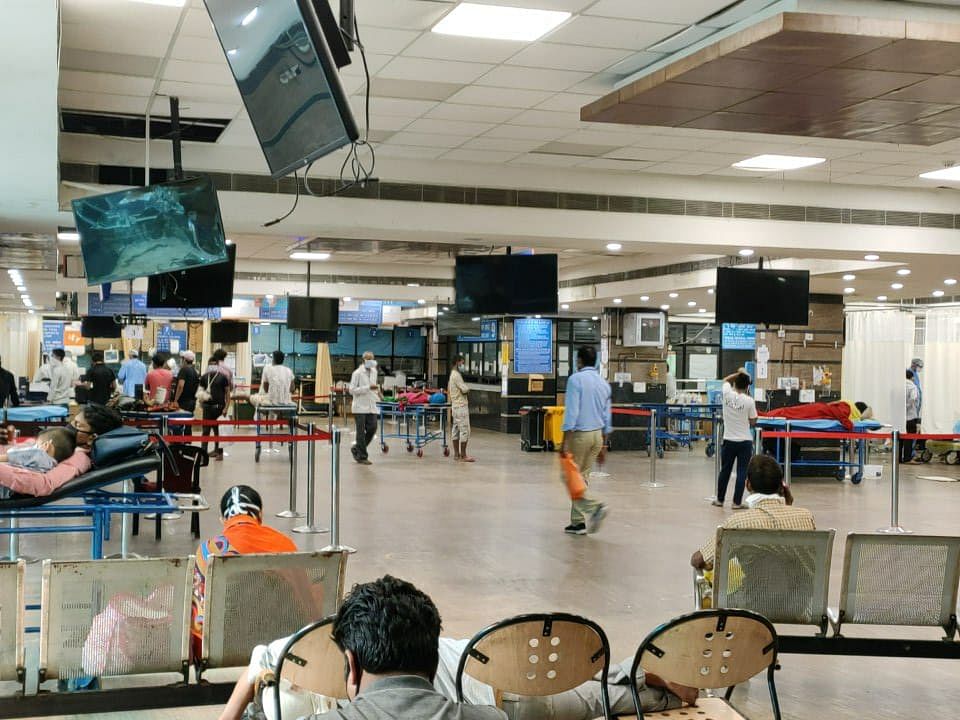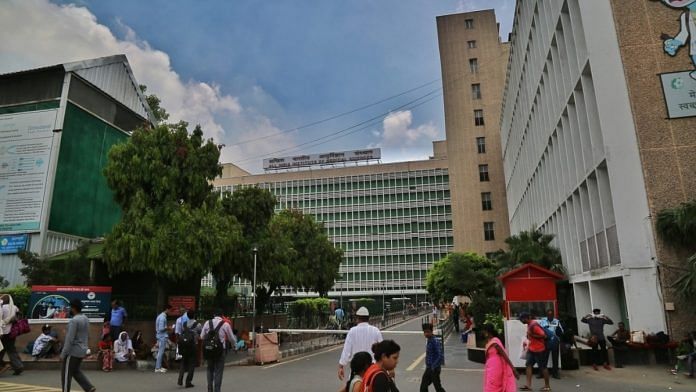New Delhi: Doctors using ultrasound machines instead of stethoscopes, more protection for personnel, telemedicine, and treating all incoming patients as suspected Covid-19 cases — these are some new measures the All India Institute of Medical Sciences (AIIMS) is taking as healthcare at the premiere institute in the national capital seems set for a new course.
The hospital is now cautiously reopening its outpatient department (OPD) facilities, which it had shut three and a half months ago along with specialty clinic services — for the first time in its 64-year history — in the wake of the pandemic.
Vikas Kumar, who has been a security guard at AIIMS for eight years, said he has never seen the hospital complex as empty as it is now. “This has never happened before,” Kumar said. Under normal circumstances, Kumar would manage hundreds of patients jostling for appointments and medical attention. “Patients used to line up at 3 am for appointments that began at 9.30 the next morning.”
The OPD used to see 10,000-15,000 patients daily before the lockdown came into effect on 25 March.
Now, patients are beginning to trickle in as the hospital gradually reopens the OPD section, with departments seeing a little over 1,000 patients every day. From 23 June, each department was allowed not more than 15 follow-up patients with prior appointments per day.
On Tuesday, departments were given the go-ahead to treat an additional 30 patients, some of them first-time consultations.
ThePrint reached AIIMS Director Dr Randeep Guleria, official spokesperson Dr Aarti Vij and medical superintendent D.K. Sharma via text and calls for comments on how the institute is coping, but there was no response till the time of publishing this report.
Many doctors, however, said healthcare at AIIMS will never be the same, with the institute now introducing new systems to counter the new challenges.
Also read: How Lakshadweep has managed to be India’s only territory without coronavirus
Telemedicine
Among the biggest changes AIIMS has seen is the rise in telemedicine. On 28 March, AIIMS launched the Covid-19 National Teleconsultation Centre (CoNTeC) to help patients and other doctors in need of medical guidance for the management of Covid.
A group of 50 doctors have answered over 25,000 calls to date, Dr A. Sharif, who is overseeing the call centre, told ThePrint.
Sharif is an additional professor at the institute involved in curriculum development for medical students, but dabbles with technology. He was made in-charge of the hospital’s telemedicine facility and implemented an open-source helpline system that would connect callers to doctors while keeping the data of the call private.
“We get more calls each day. Most are AIIMS patients seeking appointments from various departments. Even though this was a Covid helpline, we try to help the patient any way we can,” Sharif said.
The CoNTec helpline has aided thousands of patients in securing appointments with various departments, apart from serving as an informal helpline for those in medical distress. When a patient calls seeking an appointment at one of the hospital’s facilities under OPD, the volunteer directs the call to a data entry operator who then facilitates a call back from the department concerned.
Until the end of June, over 69,000 teleconsultations across various departments had taken place.
“Only patients who absolutely require OPD services are coming in. When doctors from the concerned department get a request for an appointment, they evaluate the patient’s history before taking a call about whether to see them or advise them over the phone,” said Sharif.
CoNTec has also served a second purpose: helping doctors across the nation — including from small towns and villages — connect with doctors from AIIMS for up-to-date information on how to treat Covid patients.
States may have their own protocols when it comes to the clinical management of Covid, but Dr Vijay Hadda, one of CoNTec’s nodal officers, explained that it takes a while for that information to seep through.
“Being a premier institute, everyone looks to us for answers. We once got a call from a medical superintendent from a district hospital in Rajasthan asking how to dispose of Covid medical waste. I didn’t know the answer myself, so I found out how we did it by talking to our nurses and resident staff before calling him back,” said Hadda.
The telemedicine system is here to stay, said Sharif.
Wrong numbers, ‘shy patients’
While some departments like neurology and dermatology have taken well to this emerging model of consultations, others, like the department of surgery, have not found it as useful.
“We’re not trained for telemedicine, so initially we were skeptical of using it. But the pandemic has really given us no other choice,” said Dr Vishnu V.Y., assistant professor of neurology. “It’s easier to do consultations with follow-up patients, and these lockdown months have reassured me that it’s possible to practise good quality medicine through video conferencing.”
But problems persist: Of 21 telemedicine appointments in a day, Vishnu said he’s able to finally connect with about 60 to 70 per cent of the patients, “because either they’ve given a wrong number, or contacted us through a relative who is now no longer with the patient”.
Without face-to-face meetings, Hadda said, patients are often found shy to admit their problems.
“Meeting and touching a patient often instills confidence in them. With that gone, there’s a sense of formality that may prevent frank discussion of an issue,” he said.
Doctors feel telemedicine will need to become more user-friendly to gain the trust of both patients and doctors, but it has the potential to become a permanent fixture in the post-Covid world.
“There is no reason why patients have to travel thousands of kilometres for a consultation which on an average takes 5-10 minutes,” said Dr Vijay Gurjar, assistant professor, Department of Geriatric Medicine, AIIMS. “I foresee a future where there will be booths like STD/ISD where patients can seek consultation from experts afar.”
Also read: Covid recovery rate in Bengal dips sharply in last 2 weeks, experts unable to find reason

Physical distancing in OPDs
Departments that share OPD space are, meanwhile, yet to figure out how incoming patients will be tended to.
“For example, we share our OPD space with cardiology and neurosurgery departments. Till now (since the OPD opened in June), ours was the only OPD that was accepting patients,” said Vishnu. “Now, we would need to have an interdepartmental meeting to discuss how to include new patients while maintaining physical distancing.”
Some patients need to get hospitalised to get all the diagnostic tests done, which has stopped due to the lockdown, said Gurjar.
“Especially in the case of malignancies and cancers, patients need to get admitted which they were unwilling to do so for the fear of contracting the virus in the hospital,” he said, adding that there needs to be a balance between delaying elective procedures and getting a necessary procedure done in a hospital.
Also read: IIT-Delhi’s RT-PCR kit, with base price of Rs 399, opens new avenue for cheaper Covid tests
More rigour in the wards
Mohammed Jesal, joint secretary, AIIMS nurses union, said, “Before the coronavirus pandemic, I had seen doctors at AIIMS tend to a patient in full PPE only once… In 2014, when a patient came in with ‘Congo virus’. Now when we work in Emergency we can’t work without Level 3 PPE. I never would have thought it would come to this.”
Nurses and doctors on both Covid and non-Covid duty are equipped with different levels of personal protection at all times now, Jesal said. “We don’t know who’s coming in when it’s an emergency patient, so everyone has to wear PPE there. But when we look at a patient in the OPD, we may not need to wear it at all.”
As part of the protocol, all patients admitted for emergencies are treated as suspected patients and first tested by rapid antigen tests and then RT-PCR tests. The institute has also ramped up testing for all patients who are undergoing any inpatient care and for those scheduled for surgeries.
In wards, at the foot of patient’s beds is a record of every doctor or healthcare worker who has come in contact with the patient and at what time, to help with contact tracing if ever the need arises. Doctors now invariably rely more on patients’ history and investigation than on physical examinations.
“In a way, this is more rigorous because patients are being asked to do more tests, which can help us diagnose,” said Dr Umang Arora, a second-year internal medicine resident working in non-Covid ICU duty.
Also read: How decades of work on elusive HIV vaccine has given hope for a ‘quick’ Covid vaccine
Ultrasounds instead of stethoscopes
With Covid threat, the role of ultrasounds has become more important in visualising internal organs because doctors cannot use a stethoscope while wearing the PPE, and all patients may not have respiratory symptoms.
“Stethoscopes would need patients to take deep breaths, exhale out and even cough which is not advisable today, so we are directly using the ultrasound machines to examine the lungs and look for infections or pneumonia,” said Dr Prerna Garg, junior resident, internal medicine, who works in Covid ward and ICU.
This is easier to do in AIIMS because ultrasound machines are available at the point of care in emergency units, wards and ICUs, and are being used more extensively now even for intubation or the process inserting ventilator tubes in the airway of the patient, she added.
Infected workers
Despite all the precautions, about 200 out of the 5,000 nurses at AIIMS have been infected with Covid.
The number of infected healthcare workers including doctors, nurses, sanitation staff as well as their families is above 1,000, said another doctor working on the institute’s employee health system, which is open for all employees and their families to test for Covid.
“In June, out of 250-300 tests we conducted daily, 50-75 tests came out positive, which is slowly declining in July,” the doctor said.
Also read: Coronavirus infection transmitted from mother to foetus in France



